| diagram | 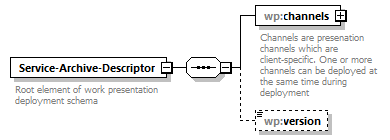 |
||
| namespace | http://service.archive.wp.n2.tibco.com | ||
| properties |
|
||
| children | wp:channels wp:version | ||
| annotation |
|
||
| source | <xsd:element name="Service-Archive-Descriptor"> <xsd:annotation> <xsd:documentation>Root element of work presentation deployment schema</xsd:documentation> </xsd:annotation> <xsd:complexType> <xsd:sequence> <xsd:element name="channels"> <xsd:annotation> <xsd:documentation>Channels are presenation channels which are client-specific. One or more channels can be deployed at the same time during deployment</xsd:documentation> </xsd:annotation> <xsd:complexType> <xsd:sequence> <xsd:element name="channel" maxOccurs="unbounded"> <xsd:annotation> <xsd:documentation>Channel is a presentation channel.At least one channel needs to be specified during deployment.It is possible to just deploy the channel without deploying the assosciate resources or can be a full fledged channel deployment with associated work model type and its resources</xsd:documentation> </xsd:annotation> <xsd:complexType> <xsd:sequence> <xsd:element name="description" type="xs:string" nillable="true" minOccurs="0"> <xsd:annotation> <xsd:documentation>Description of the channel that is getting deployed. </xsd:documentation> </xsd:annotation> </xsd:element> <xsd:element name="target-channel-type" type="ct:ChannelType"> <xsd:annotation> <xsd:documentation>Target channel type indicates the client type of channel for viewing the presentation. EMAIL channel is a channel type which might be capable of displaying JSP/Forms/MS-Word type of presentations. </xsd:documentation> </xsd:annotation> </xsd:element> <xsd:element name="presentation-channel-type" type="ct:PresentationType"> <xsd:annotation> <xsd:documentation>presentation type specifies the rendering engine type for the presentation.It can be something like JSP,GI,RCP..etc </xsd:documentation> </xsd:annotation> </xsd:element> <xsd:element name="implementation-type" type="ct:ImplementationType"> <xsd:annotation> <xsd:documentation>Implementation type specifies the fulfillment type of the presentation.This fulfillment type can be a server push/pull </xsd:documentation> </xsd:annotation> </xsd:element> <xsd:element name="work-type" minOccurs="0" maxOccurs="unbounded"> <xsd:annotation> <xsd:documentation>WorkModel type is the work type/work model type defined in BRM.It is assumed that in runtime that work types/ work model types are already deployed and activated before the work presentation request is made.Same work model type can be associated to different presentation forms based on the channel specified. </xsd:documentation> </xsd:annotation> <xsd:complexType> <xsd:sequence> <xsd:element name="extended-properties" type="wp:extendedPropertiesType" nillable="true" minOccurs="0"> <xsd:annotation> <xsd:documentation> It is a provision to add custom properties to the work model type which can be interpreted by the Work Presenation Deployment Analyser </xsd:documentation> </xsd:annotation> </xsd:element> <xsd:choice> <xsd:element name="form" type="wp:formType"> <xsd:annotation> <xsd:documentation> Form indicates the presentation resource that needs to be displayed for this particular work type request </xsd:documentation> </xsd:annotation> </xsd:element> <xsd:element name="page-flow" type="wp:pageFlowType" nillable="false"/> <xsd:element name="extension-config" type="wp:channelExtentionType"/> <xsd:element name="page-flow-ref" type="wp:pageFlowRefType"/> </xsd:choice> </xsd:sequence> <xsd:attribute name="guid" type="xs:string" use="required"/> <xsd:attribute name="name" type="xs:string" use="optional"/> <xsd:attribute name="version" type="xs:string" use="optional"/> </xsd:complexType> </xsd:element> <xsd:element name="domain" type="xs:string" minOccurs="0"/> <xsd:element name="extended-properties" type="wp:extendedPropertiesType" nillable="true" minOccurs="0"> <xsd:annotation> <xsd:documentation>It is a provision to add custom properties to the work model type which can be interpreted by the Work Presenation Deployment Analyser. </xsd:documentation> </xsd:annotation> </xsd:element> <xsd:element name="extension-config" type="wp:channelExtentionType" nillable="true" minOccurs="0"> <xsd:annotation> <xsd:documentation>Defines extended channel information, for example, Email Channel, or for a channel not yet implemented in WP. </xsd:documentation> </xsd:annotation> </xsd:element> <xsd:element name="business-service" type="wp:businessServiceType" minOccurs="0" maxOccurs="unbounded"> <xsd:annotation> <xsd:documentation>Defines pageflow business service form related resources. </xsd:documentation> </xsd:annotation> </xsd:element> <xsd:element name="page-flow" type="wp:pageFlowType" minOccurs="0" maxOccurs="unbounded"/> </xsd:sequence> <xsd:attribute name="version" type="xs:string" use="optional"/> <xsd:attribute name="channelId" type="xs:string" use="required"/> <xsd:attribute name="name" type="xs:string" use="optional"/> <xsd:attribute name="defaultChannel" type="xs:boolean"> <xsd:annotation> <xsd:documentation>Is this a default channel for the target channel type. Note there should be only one default channel per channel type.</xsd:documentation> </xsd:annotation> </xsd:attribute> </xsd:complexType> </xsd:element> </xsd:sequence> </xsd:complexType> </xsd:element> <xsd:element name="version" minOccurs="0"/> </xsd:sequence> </xsd:complexType> </xsd:element> |
element Service-Archive-Descriptor/channels
| diagram | 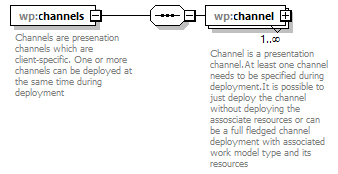 |
||
| namespace | http://service.archive.wp.n2.tibco.com | ||
| properties |
|
||
| children | wp:channel | ||
| annotation |
|
||
| source | <xsd:element name="channels"> <xsd:annotation> <xsd:documentation>Channels are presenation channels which are client-specific. One or more channels can be deployed at the same time during deployment</xsd:documentation> </xsd:annotation> <xsd:complexType> <xsd:sequence> <xsd:element name="channel" maxOccurs="unbounded"> <xsd:annotation> <xsd:documentation>Channel is a presentation channel.At least one channel needs to be specified during deployment.It is possible to just deploy the channel without deploying the assosciate resources or can be a full fledged channel deployment with associated work model type and its resources</xsd:documentation> </xsd:annotation> <xsd:complexType> <xsd:sequence> <xsd:element name="description" type="xs:string" nillable="true" minOccurs="0"> <xsd:annotation> <xsd:documentation>Description of the channel that is getting deployed. </xsd:documentation> </xsd:annotation> </xsd:element> <xsd:element name="target-channel-type" type="ct:ChannelType"> <xsd:annotation> <xsd:documentation>Target channel type indicates the client type of channel for viewing the presentation. EMAIL channel is a channel type which might be capable of displaying JSP/Forms/MS-Word type of presentations. </xsd:documentation> </xsd:annotation> </xsd:element> <xsd:element name="presentation-channel-type" type="ct:PresentationType"> <xsd:annotation> <xsd:documentation>presentation type specifies the rendering engine type for the presentation.It can be something like JSP,GI,RCP..etc </xsd:documentation> </xsd:annotation> </xsd:element> <xsd:element name="implementation-type" type="ct:ImplementationType"> <xsd:annotation> <xsd:documentation>Implementation type specifies the fulfillment type of the presentation.This fulfillment type can be a server push/pull </xsd:documentation> </xsd:annotation> </xsd:element> <xsd:element name="work-type" minOccurs="0" maxOccurs="unbounded"> <xsd:annotation> <xsd:documentation>WorkModel type is the work type/work model type defined in BRM.It is assumed that in runtime that work types/ work model types are already deployed and activated before the work presentation request is made.Same work model type can be associated to different presentation forms based on the channel specified. </xsd:documentation> </xsd:annotation> <xsd:complexType> <xsd:sequence> <xsd:element name="extended-properties" type="wp:extendedPropertiesType" nillable="true" minOccurs="0"> <xsd:annotation> <xsd:documentation> It is a provision to add custom properties to the work model type which can be interpreted by the Work Presenation Deployment Analyser </xsd:documentation> </xsd:annotation> </xsd:element> <xsd:choice> <xsd:element name="form" type="wp:formType"> <xsd:annotation> <xsd:documentation> Form indicates the presentation resource that needs to be displayed for this particular work type request </xsd:documentation> </xsd:annotation> </xsd:element> <xsd:element name="page-flow" type="wp:pageFlowType" nillable="false"/> <xsd:element name="extension-config" type="wp:channelExtentionType"/> <xsd:element name="page-flow-ref" type="wp:pageFlowRefType"/> </xsd:choice> </xsd:sequence> <xsd:attribute name="guid" type="xs:string" use="required"/> <xsd:attribute name="name" type="xs:string" use="optional"/> <xsd:attribute name="version" type="xs:string" use="optional"/> </xsd:complexType> </xsd:element> <xsd:element name="domain" type="xs:string" minOccurs="0"/> <xsd:element name="extended-properties" type="wp:extendedPropertiesType" nillable="true" minOccurs="0"> <xsd:annotation> <xsd:documentation>It is a provision to add custom properties to the work model type which can be interpreted by the Work Presenation Deployment Analyser. </xsd:documentation> </xsd:annotation> </xsd:element> <xsd:element name="extension-config" type="wp:channelExtentionType" nillable="true" minOccurs="0"> <xsd:annotation> <xsd:documentation>Defines extended channel information, for example, Email Channel, or for a channel not yet implemented in WP. </xsd:documentation> </xsd:annotation> </xsd:element> <xsd:element name="business-service" type="wp:businessServiceType" minOccurs="0" maxOccurs="unbounded"> <xsd:annotation> <xsd:documentation>Defines pageflow business service form related resources. </xsd:documentation> </xsd:annotation> </xsd:element> <xsd:element name="page-flow" type="wp:pageFlowType" minOccurs="0" maxOccurs="unbounded"/> </xsd:sequence> <xsd:attribute name="version" type="xs:string" use="optional"/> <xsd:attribute name="channelId" type="xs:string" use="required"/> <xsd:attribute name="name" type="xs:string" use="optional"/> <xsd:attribute name="defaultChannel" type="xs:boolean"> <xsd:annotation> <xsd:documentation>Is this a default channel for the target channel type. Note there should be only one default channel per channel type.</xsd:documentation> </xsd:annotation> </xsd:attribute> </xsd:complexType> </xsd:element> </xsd:sequence> </xsd:complexType> </xsd:element> |
element Service-Archive-Descriptor/channels/channel
| diagram |  |
||||||||||||||||||||||||||||||||
| namespace | http://service.archive.wp.n2.tibco.com | ||||||||||||||||||||||||||||||||
| properties |
|
||||||||||||||||||||||||||||||||
| children | wp:description wp:target-channel-type wp:presentation-channel-type wp:implementation-type wp:work-type wp:domain wp:extended-properties wp:extension-config wp:business-service wp:page-flow | ||||||||||||||||||||||||||||||||
| attributes |
|
||||||||||||||||||||||||||||||||
| annotation |
|
||||||||||||||||||||||||||||||||
| source | <xsd:element name="channel" maxOccurs="unbounded"> <xsd:annotation> <xsd:documentation>Channel is a presentation channel.At least one channel needs to be specified during deployment.It is possible to just deploy the channel without deploying the assosciate resources or can be a full fledged channel deployment with associated work model type and its resources</xsd:documentation> </xsd:annotation> <xsd:complexType> <xsd:sequence> <xsd:element name="description" type="xs:string" nillable="true" minOccurs="0"> <xsd:annotation> <xsd:documentation>Description of the channel that is getting deployed. </xsd:documentation> </xsd:annotation> </xsd:element> <xsd:element name="target-channel-type" type="ct:ChannelType"> <xsd:annotation> <xsd:documentation>Target channel type indicates the client type of channel for viewing the presentation. EMAIL channel is a channel type which might be capable of displaying JSP/Forms/MS-Word type of presentations. </xsd:documentation> </xsd:annotation> </xsd:element> <xsd:element name="presentation-channel-type" type="ct:PresentationType"> <xsd:annotation> <xsd:documentation>presentation type specifies the rendering engine type for the presentation.It can be something like JSP,GI,RCP..etc </xsd:documentation> </xsd:annotation> </xsd:element> <xsd:element name="implementation-type" type="ct:ImplementationType"> <xsd:annotation> <xsd:documentation>Implementation type specifies the fulfillment type of the presentation.This fulfillment type can be a server push/pull </xsd:documentation> </xsd:annotation> </xsd:element> <xsd:element name="work-type" minOccurs="0" maxOccurs="unbounded"> <xsd:annotation> <xsd:documentation>WorkModel type is the work type/work model type defined in BRM.It is assumed that in runtime that work types/ work model types are already deployed and activated before the work presentation request is made.Same work model type can be associated to different presentation forms based on the channel specified. </xsd:documentation> </xsd:annotation> <xsd:complexType> <xsd:sequence> <xsd:element name="extended-properties" type="wp:extendedPropertiesType" nillable="true" minOccurs="0"> <xsd:annotation> <xsd:documentation> It is a provision to add custom properties to the work model type which can be interpreted by the Work Presenation Deployment Analyser </xsd:documentation> </xsd:annotation> </xsd:element> <xsd:choice> <xsd:element name="form" type="wp:formType"> <xsd:annotation> <xsd:documentation> Form indicates the presentation resource that needs to be displayed for this particular work type request </xsd:documentation> </xsd:annotation> </xsd:element> <xsd:element name="page-flow" type="wp:pageFlowType" nillable="false"/> <xsd:element name="extension-config" type="wp:channelExtentionType"/> <xsd:element name="page-flow-ref" type="wp:pageFlowRefType"/> </xsd:choice> </xsd:sequence> <xsd:attribute name="guid" type="xs:string" use="required"/> <xsd:attribute name="name" type="xs:string" use="optional"/> <xsd:attribute name="version" type="xs:string" use="optional"/> </xsd:complexType> </xsd:element> <xsd:element name="domain" type="xs:string" minOccurs="0"/> <xsd:element name="extended-properties" type="wp:extendedPropertiesType" nillable="true" minOccurs="0"> <xsd:annotation> <xsd:documentation>It is a provision to add custom properties to the work model type which can be interpreted by the Work Presenation Deployment Analyser. </xsd:documentation> </xsd:annotation> </xsd:element> <xsd:element name="extension-config" type="wp:channelExtentionType" nillable="true" minOccurs="0"> <xsd:annotation> <xsd:documentation>Defines extended channel information, for example, Email Channel, or for a channel not yet implemented in WP. </xsd:documentation> </xsd:annotation> </xsd:element> <xsd:element name="business-service" type="wp:businessServiceType" minOccurs="0" maxOccurs="unbounded"> <xsd:annotation> <xsd:documentation>Defines pageflow business service form related resources. </xsd:documentation> </xsd:annotation> </xsd:element> <xsd:element name="page-flow" type="wp:pageFlowType" minOccurs="0" maxOccurs="unbounded"/> </xsd:sequence> <xsd:attribute name="version" type="xs:string" use="optional"/> <xsd:attribute name="channelId" type="xs:string" use="required"/> <xsd:attribute name="name" type="xs:string" use="optional"/> <xsd:attribute name="defaultChannel" type="xs:boolean"> <xsd:annotation> <xsd:documentation>Is this a default channel for the target channel type. Note there should be only one default channel per channel type.</xsd:documentation> </xsd:annotation> </xsd:attribute> </xsd:complexType> </xsd:element> |
attribute Service-Archive-Descriptor/channels/channel/@version
| type | xs:string | ||
| properties |
|
||
| source | <xsd:attribute name="version" type="xs:string" use="optional"/> |
attribute Service-Archive-Descriptor/channels/channel/@channelId
| type | xs:string | ||
| properties |
|
||
| source | <xsd:attribute name="channelId" type="xs:string" use="required"/> |
attribute Service-Archive-Descriptor/channels/channel/@name
| type | xs:string | ||
| properties |
|
||
| source | <xsd:attribute name="name" type="xs:string" use="optional"/> |
attribute Service-Archive-Descriptor/channels/channel/@defaultChannel
| type | xs:boolean | ||
| annotation |
|
||
| source | <xsd:attribute name="defaultChannel" type="xs:boolean"> <xsd:annotation> <xsd:documentation>Is this a default channel for the target channel type. Note there should be only one default channel per channel type.</xsd:documentation> </xsd:annotation> </xsd:attribute> |
element Service-Archive-Descriptor/channels/channel/description
| diagram |  |
||||||||
| namespace | http://service.archive.wp.n2.tibco.com | ||||||||
| type | xs:string | ||||||||
| properties |
|
||||||||
| annotation |
|
||||||||
| source | <xsd:element name="description" type="xs:string" nillable="true" minOccurs="0"> <xsd:annotation> <xsd:documentation>Description of the channel that is getting deployed. </xsd:documentation> </xsd:annotation> </xsd:element> |
element Service-Archive-Descriptor/channels/channel/target-channel-type
| diagram | 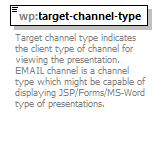 |
||||||||||||||||||||||||
| namespace | http://service.archive.wp.n2.tibco.com | ||||||||||||||||||||||||
| type | ChannelType | ||||||||||||||||||||||||
| properties |
|
||||||||||||||||||||||||
| facets |
|
||||||||||||||||||||||||
| annotation |
|
||||||||||||||||||||||||
| source | <xsd:element name="target-channel-type" type="ct:ChannelType"> <xsd:annotation> <xsd:documentation>Target channel type indicates the client type of channel for viewing the presentation. EMAIL channel is a channel type which might be capable of displaying JSP/Forms/MS-Word type of presentations. </xsd:documentation> </xsd:annotation> </xsd:element> |
element Service-Archive-Descriptor/channels/channel/presentation-channel-type
| diagram | 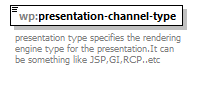 |
||||||||||||||||||||||||
| namespace | http://service.archive.wp.n2.tibco.com | ||||||||||||||||||||||||
| type | PresentationType | ||||||||||||||||||||||||
| properties |
|
||||||||||||||||||||||||
| facets |
|
||||||||||||||||||||||||
| annotation |
|
||||||||||||||||||||||||
| source | <xsd:element name="presentation-channel-type" type="ct:PresentationType"> <xsd:annotation> <xsd:documentation>presentation type specifies the rendering engine type for the presentation.It can be something like JSP,GI,RCP..etc </xsd:documentation> </xsd:annotation> </xsd:element> |
element Service-Archive-Descriptor/channels/channel/implementation-type
| diagram | 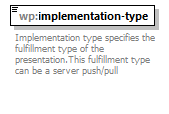 |
|||||||||
| namespace | http://service.archive.wp.n2.tibco.com | |||||||||
| type | ImplementationType | |||||||||
| properties |
|
|||||||||
| facets |
|
|||||||||
| annotation |
|
|||||||||
| source | <xsd:element name="implementation-type" type="ct:ImplementationType"> <xsd:annotation> <xsd:documentation>Implementation type specifies the fulfillment type of the presentation.This fulfillment type can be a server push/pull </xsd:documentation> </xsd:annotation> </xsd:element> |
element Service-Archive-Descriptor/channels/channel/work-type
| diagram |  |
||||||||||||||||||||||||
| namespace | http://service.archive.wp.n2.tibco.com | ||||||||||||||||||||||||
| properties |
|
||||||||||||||||||||||||
| children | wp:extended-properties wp:form wp:page-flow wp:extension-config wp:page-flow-ref | ||||||||||||||||||||||||
| attributes |
|
||||||||||||||||||||||||
| annotation |
|
||||||||||||||||||||||||
| source | <xsd:element name="work-type" minOccurs="0" maxOccurs="unbounded"> <xsd:annotation> <xsd:documentation>WorkModel type is the work type/work model type defined in BRM.It is assumed that in runtime that work types/ work model types are already deployed and activated before the work presentation request is made.Same work model type can be associated to different presentation forms based on the channel specified. </xsd:documentation> </xsd:annotation> <xsd:complexType> <xsd:sequence> <xsd:element name="extended-properties" type="wp:extendedPropertiesType" nillable="true" minOccurs="0"> <xsd:annotation> <xsd:documentation> It is a provision to add custom properties to the work model type which can be interpreted by the Work Presenation Deployment Analyser </xsd:documentation> </xsd:annotation> </xsd:element> <xsd:choice> <xsd:element name="form" type="wp:formType"> <xsd:annotation> <xsd:documentation> Form indicates the presentation resource that needs to be displayed for this particular work type request </xsd:documentation> </xsd:annotation> </xsd:element> <xsd:element name="page-flow" type="wp:pageFlowType" nillable="false"/> <xsd:element name="extension-config" type="wp:channelExtentionType"/> <xsd:element name="page-flow-ref" type="wp:pageFlowRefType"/> </xsd:choice> </xsd:sequence> <xsd:attribute name="guid" type="xs:string" use="required"/> <xsd:attribute name="name" type="xs:string" use="optional"/> <xsd:attribute name="version" type="xs:string" use="optional"/> </xsd:complexType> </xsd:element> |
attribute Service-Archive-Descriptor/channels/channel/work-type/@guid
| type | xs:string | ||
| properties |
|
||
| source | <xsd:attribute name="guid" type="xs:string" use="required"/> |
attribute Service-Archive-Descriptor/channels/channel/work-type/@name
| type | xs:string | ||
| properties |
|
||
| source | <xsd:attribute name="name" type="xs:string" use="optional"/> |
attribute Service-Archive-Descriptor/channels/channel/work-type/@version
| type | xs:string | ||
| properties |
|
||
| source | <xsd:attribute name="version" type="xs:string" use="optional"/> |
element Service-Archive-Descriptor/channels/channel/work-type/extended-properties
| diagram | 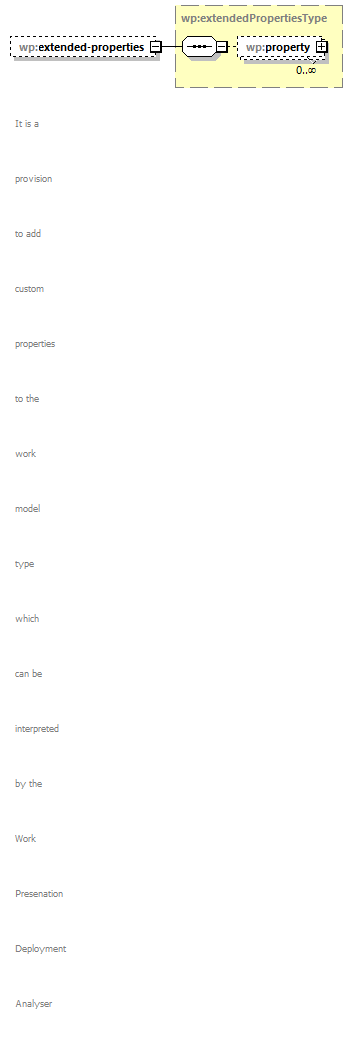 |
||||||||
| namespace | http://service.archive.wp.n2.tibco.com | ||||||||
| type | wp:extendedPropertiesType | ||||||||
| properties |
|
||||||||
| children | wp:property | ||||||||
| annotation |
|
||||||||
| source | <xsd:element name="extended-properties" type="wp:extendedPropertiesType" nillable="true" minOccurs="0"> <xsd:annotation> <xsd:documentation> It is a provision to add custom properties to the work model type which can be interpreted by the Work Presenation Deployment Analyser </xsd:documentation> </xsd:annotation> </xsd:element> |
element Service-Archive-Descriptor/channels/channel/work-type/form
| diagram | 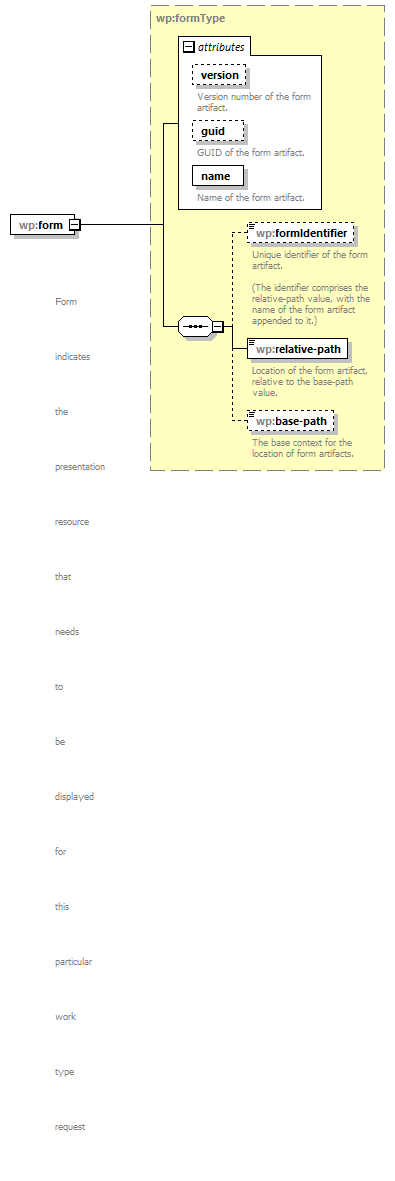 |
||||||||||||||||||||||||||||||
| namespace | http://service.archive.wp.n2.tibco.com | ||||||||||||||||||||||||||||||
| type | wp:formType | ||||||||||||||||||||||||||||||
| properties |
|
||||||||||||||||||||||||||||||
| children | wp:formIdentifier wp:relative-path wp:base-path | ||||||||||||||||||||||||||||||
| attributes |
|
||||||||||||||||||||||||||||||
| annotation |
|
||||||||||||||||||||||||||||||
| source | <xsd:element name="form" type="wp:formType"> <xsd:annotation> <xsd:documentation> Form indicates the presentation resource that needs to be displayed for this particular work type request </xsd:documentation> </xsd:annotation> </xsd:element> |
element Service-Archive-Descriptor/channels/channel/work-type/page-flow
| diagram | 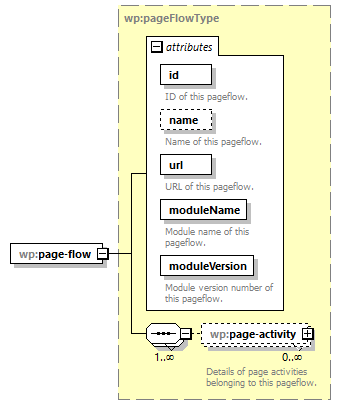 |
||||||||||||||||||||||||||||||||||||||||||||||
| namespace | http://service.archive.wp.n2.tibco.com | ||||||||||||||||||||||||||||||||||||||||||||||
| type | wp:pageFlowType | ||||||||||||||||||||||||||||||||||||||||||||||
| properties |
|
||||||||||||||||||||||||||||||||||||||||||||||
| children | wp:page-activity | ||||||||||||||||||||||||||||||||||||||||||||||
| attributes |
|
||||||||||||||||||||||||||||||||||||||||||||||
| source | <xsd:element name="page-flow" type="wp:pageFlowType" nillable="false"/> |
element Service-Archive-Descriptor/channels/channel/work-type/extension-config
| diagram | 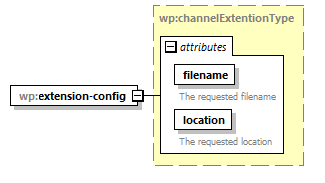 |
||||||||||||||||||||||
| namespace | http://service.archive.wp.n2.tibco.com | ||||||||||||||||||||||
| type | wp:channelExtentionType | ||||||||||||||||||||||
| properties |
|
||||||||||||||||||||||
| attributes |
|
||||||||||||||||||||||
| source | <xsd:element name="extension-config" type="wp:channelExtentionType"/> |
element Service-Archive-Descriptor/channels/channel/work-type/page-flow-ref
| diagram | 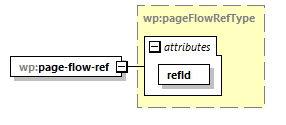 |
||||||||||||
| namespace | http://service.archive.wp.n2.tibco.com | ||||||||||||
| type | wp:pageFlowRefType | ||||||||||||
| properties |
|
||||||||||||
| attributes |
|
||||||||||||
| source | <xsd:element name="page-flow-ref" type="wp:pageFlowRefType"/> |
element Service-Archive-Descriptor/channels/channel/domain
| diagram |  |
||||||
| namespace | http://service.archive.wp.n2.tibco.com | ||||||
| type | xs:string | ||||||
| properties |
|
||||||
| source | <xsd:element name="domain" type="xs:string" minOccurs="0"/> |
element Service-Archive-Descriptor/channels/channel/extended-properties
| diagram | 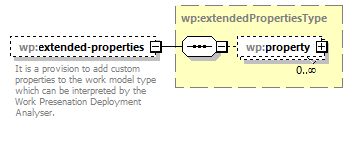 |
||||||||
| namespace | http://service.archive.wp.n2.tibco.com | ||||||||
| type | wp:extendedPropertiesType | ||||||||
| properties |
|
||||||||
| children | wp:property | ||||||||
| annotation |
|
||||||||
| source | <xsd:element name="extended-properties" type="wp:extendedPropertiesType" nillable="true" minOccurs="0"> <xsd:annotation> <xsd:documentation>It is a provision to add custom properties to the work model type which can be interpreted by the Work Presenation Deployment Analyser. </xsd:documentation> </xsd:annotation> </xsd:element> |
element Service-Archive-Descriptor/channels/channel/extension-config
| diagram | 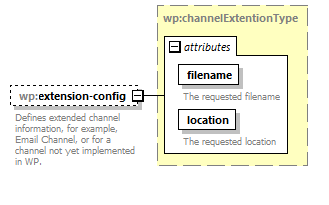 |
||||||||||||||||||||||
| namespace | http://service.archive.wp.n2.tibco.com | ||||||||||||||||||||||
| type | wp:channelExtentionType | ||||||||||||||||||||||
| properties |
|
||||||||||||||||||||||
| attributes |
|
||||||||||||||||||||||
| annotation |
|
||||||||||||||||||||||
| source | <xsd:element name="extension-config" type="wp:channelExtentionType" nillable="true" minOccurs="0"> <xsd:annotation> <xsd:documentation>Defines extended channel information, for example, Email Channel, or for a channel not yet implemented in WP. </xsd:documentation> </xsd:annotation> </xsd:element> |
element Service-Archive-Descriptor/channels/channel/business-service
| diagram | 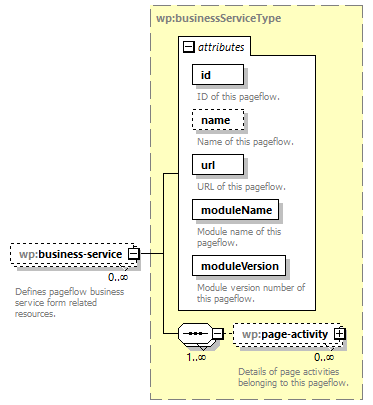 |
||||||||||||||||||||||||||||||||||||||||||||||
| namespace | http://service.archive.wp.n2.tibco.com | ||||||||||||||||||||||||||||||||||||||||||||||
| type | wp:businessServiceType | ||||||||||||||||||||||||||||||||||||||||||||||
| properties |
|
||||||||||||||||||||||||||||||||||||||||||||||
| children | wp:page-activity | ||||||||||||||||||||||||||||||||||||||||||||||
| attributes |
|
||||||||||||||||||||||||||||||||||||||||||||||
| annotation |
|
||||||||||||||||||||||||||||||||||||||||||||||
| source | <xsd:element name="business-service" type="wp:businessServiceType" minOccurs="0" maxOccurs="unbounded"> <xsd:annotation> <xsd:documentation>Defines pageflow business service form related resources. </xsd:documentation> </xsd:annotation> </xsd:element> |
element Service-Archive-Descriptor/channels/channel/page-flow
| diagram | 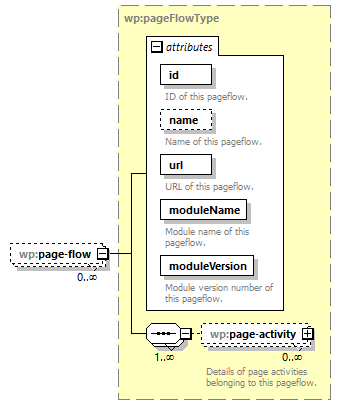 |
||||||||||||||||||||||||||||||||||||||||||||||
| namespace | http://service.archive.wp.n2.tibco.com | ||||||||||||||||||||||||||||||||||||||||||||||
| type | wp:pageFlowType | ||||||||||||||||||||||||||||||||||||||||||||||
| properties |
|
||||||||||||||||||||||||||||||||||||||||||||||
| children | wp:page-activity | ||||||||||||||||||||||||||||||||||||||||||||||
| attributes |
|
||||||||||||||||||||||||||||||||||||||||||||||
| source | <xsd:element name="page-flow" type="wp:pageFlowType" minOccurs="0" maxOccurs="unbounded"/> |
element Service-Archive-Descriptor/version
| diagram |  |
||||
| namespace | http://service.archive.wp.n2.tibco.com | ||||
| properties |
|
||||
| source | <xsd:element name="version" minOccurs="0"/> |
WSDL documentation generated by XMLSpy WSDL Editor http://www.altova.com/xmlspy